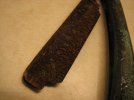t1mpani
Platinum Member
- Joined
- Jun 6, 2002
- Messages
- 5,497
Okay, I agreed to clean up/re-handle an old German straight razor that belongs to a family friend. The old handles are celluloid and in the process of breaking down, which has rusted the blade pretty well. Yes, of course, "buy a new razor" would be the simplest option, but this one has some family history and he would like to save the blade. I've got plans for the rust and bringing the blade back to working order.
So...... On the handles: of the various things I've shown him, he likes amboyna burl the best, and my thought had been to do wood on brass or stainless liners (to give the strength that a burl lacks) but then it hit me: a straight razor is a friction folder! If I were to do metal liners, is this blade going to just flop around under its own weight? The original celluloid handles were very tight and almost stretch as the blade is moved around in them, but initially I'd thought this was due to shrinking/warping.
Really appreciate any insight anyone can give---I'm used to restoring old knives but always fixed blades before and usually for the fun of it, not on heirlooms that actually mean something to someone.
So...... On the handles: of the various things I've shown him, he likes amboyna burl the best, and my thought had been to do wood on brass or stainless liners (to give the strength that a burl lacks) but then it hit me: a straight razor is a friction folder! If I were to do metal liners, is this blade going to just flop around under its own weight? The original celluloid handles were very tight and almost stretch as the blade is moved around in them, but initially I'd thought this was due to shrinking/warping.
Really appreciate any insight anyone can give---I'm used to restoring old knives but always fixed blades before and usually for the fun of it, not on heirlooms that actually mean something to someone.

